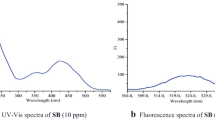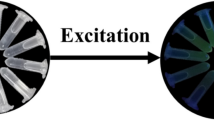Abstract
Aristolochic acids (AAs), which are a group of nitrophenanthrene carboxylic acids formed by Aristolochia plant, have become an increasing serious threat to humans due to their nephrotoxicity and carcinogenicity. Fast and accurate approaches capable of simultaneous sensing of aristolochic acids (I–IV) are vital to avoid intake of such compounds. In this research, the novel ratiometric fluorescence zinc metal-organic framework and its nanowire have been prepared. The two different coordination modes (tetrahedral configuration and twisted triangular bipyramidal configuration) within zinc metal-organic framework lead to the significant double emissions. The ratiometric fluorescence approach based on nanowire provides a broader concentration range (3.00 × 10−7~1.00 × 10−4 M) and lower limit of detection (3.70 × 10−8 M) than that based on zinc metal-organic framework (1.00 × 10−6~1.00 × 10−4 M, 5.91 × 10−7 M). The RSDs of the results are in the range 1.4–3.5% (nanowire). The density functional theory calculations and UV–Vis absorption verify that the sensing mechanism is due to charge transfer and energy transfer. Excellent spiked recoveries for AAs(I–IV) in soil and water support that nanowire is competent to simultaneously detect these targets in real samples, and the proposed approach has potential as a fluorescence sensing platform for the simultaneous detection of AAs (I–IV) in complex systems.
Graphical Abstract










Similar content being viewed by others
Data availability
The data is available with the corresponding authors upon reasonable request.
References
Wang Y, Chan W (2014) Determination of aristolochic acids by high-performance liquid chromatography with fluorescence detection. J Agric Food Chem 62(25):5859–5864. https://doi.org/10.1021/jf501609j
Grollman AP, Shibutani S, Moriya M, Miller F, Wu L, Moll U, Suzuki N, Fernandes A, Rosenquist T, Medverec Z (2007) Aristolochic acid and the etiology of endemic (Balkan) nephropathy. Proc Natl Acad Sci 104(29):12129–12134. https://doi.org/10.1073/pnas.0701248104
Au CK, Zhang J, Chan CK, Li C, Liu G, Pavlovic NM, Yao J, Chan W (2020) Determination of aristolochic acids in vegetables: nephrotoxic and carcinogenic environmental pollutants contaminating a broad swath of the food supply and driving incidence of balkan endemic nephropathy. Chem Res Toxicol 33(9):2446–2454. https://doi.org/10.1021/acs.chemrestox.0c00229
Han J, **an Z, Zhang Y, Liu J, Liang A (2019) Systematic overview of aristolochic acids: nephrotoxicity, carcinogenicity, and underlying mechanisms. Front Pharmacol 10:648. https://doi.org/10.3389/fphar.2019.00648
A JF, A JR, B LC, C DC, A HY, A WL, D WR, E ZJ, B S (2020) G. A. Fast determination of aristolochic acid I (AAI) in traditional Chinese medicine soup with magnetic solid-phase extraction by high performance liquid chromatography. J Chromatogr A 1609:460455. https://doi.org/10.1016/j.chroma.2019.460455
Yu X, Gao Y, Xu Y, Guo X, Guo L, Tan T, Liu F, Wan Y (2022) Study of the contents of analogues of aristolochic acid in Houttuynia cordata by ultra-high performance liquid chromatography tandem mass spectrometry. Foods 11(3):302. https://doi.org/10.1016/j.chroma.2019.460455
Liu JL, Xu CL, Yang T, Hu ZR, Zhang ZQ, Feng GD (2019) Developed a novel sensor based on fluorescent graft conjugated polymer for the determination of aristolochic acid in traditional Chinese medicine. Spectrochim Acta Mol Biomol Spectrosc 222:117239. https://doi.org/10.1016/j.saa.2019.117239
Lu Y, Guo Y, Liang X, Huang H, Ling X, Su Z, Liang Y (2022) The recognition of aristolochic acid I based on fluorescence quenching of bovine serum albumin-stabilized gold nanoclusters. Anal Methods 14(20):1963–1972. https://doi.org/10.1039/d2ay00492e
Ouyang L, Zhang Q, Ma G, Zhu L, Wang Y, Chen Z, Wang Y, Zhao L (2019) New dual-spectroscopic strategy for the direct detection of aristolochic acids in blood and tissue. Anal Chem 91(13):8154–8161. https://doi.org/10.1021/acs.analchem.9b00442
Yang Q, **e F-Y, Wang J-S, Yu H-Y, Li W-T, He Y-H, Pang M, Li Y, Ruan W-J (2022) Multi-dimensional ratiometric fluorescent sensing of organic disinfectants using a MOF composite with independent responsive components. Sens Actuators B 367. https://doi.org/10.1016/j.snb.2022.132041
Wu S-Q, Yin K-P, Sun Y, Su Y-Q, Yang H, Qi L-W, Peng J, Li P (2021) Gold nanoclusters-based paper sensor for the visualized detection of nephrotoxic aristolochic acids. Sens Actuators B 340:129792. https://doi.org/10.1016/j.snb.2021.129792
Lu B-B, **ng Z-X, Bao Y-S, Ye F, Fu Y (2023) Selective luminescent sensing of teflubenzuron and oxyfluorfen by a resorcin[4]arene-based metal-organic framework. Chem Eng J 452:139234. https://doi.org/10.1016/j.cej.2022.139234
Jalilian N, Ebrahimzadeh H, Asgharinezhad AA (2019) A nanosized magnetic metal-organic framework of type MIL-53 (Fe) as an efficient sorbent for coextraction of phenols and anilines prior to their quantitation by HPLC. Microchim Acta 186:1–8. https://doi.org/10.1007/s00604-019-3698-9
Asgharinezhad AA, Ebrahimzadeh H (2021) Magnetic porous carbon nanocomposite derived from cobalt based-metal-organic framework for extraction and determination of homo and hetero-polycyclic aromatic hydrocarbons. Talanta 233:122526. https://doi.org/10.1016/j.talanta.2021.122526
Asgharinezhad AA, Ebrahimzadeh H (2020) A novel polymer coated magnetic porous carbon nanocomposite derived from a metal-organic framework for multi-target environmental pollutants preconcentration. J Chromatogr A 1634:461664. https://doi.org/10.1016/j.chroma.2020.461664
Salehian S, Larimi A, Asgharinezhad AA, Khallaghi N, Borhani TN, Ghotbi C (2023) Magnetic Z-scheme bismuth molybdate (1-x)/Fe3O4@ MIL-125 (Ti)(x) nanocomposite as a high-performance visible-light-active photocatalyst for ultra-deep oxidative desulfurization of liquid fuel. Surf Interfaces 42:103432. https://doi.org/10.1016/j.surfin.2023.103432
Beshtar M, Larimi A, Asgharinezhad AA, Khorasheh F (2023) Ultra-deep photocatalytic oxidative desulfurization of model fuel using Ti-UiO-66 (zr) metal–organic framework. Catal Lett 1–15. https://doi.org/10.1007/s10562-023-04506-9
Yang L, Song Y, Wang L (2020) Multi-emission metal–organic framework composites for multicomponent ratiometric fluorescence sensing: recent developments and future challenges. J Mater Chem B 8(16):3292–3315. https://doi.org/10.1039/c9tb01931f
Spek AL (2015) PLATON SQUEEZE: a tool for the calculation of the disordered solvent contribution to the calculated structure factors. Acta Crystallogr Sect C: Struct Chem 71(1):9–18. https://doi.org/10.1107/s2053229614024929
Baig MMF, Chen Y-C (2019) Gold nanocluster-based fluorescence sensing probes for detection of dipicolinic acid. Analyst 144(10):3289–3296. https://doi.org/10.1039/C9AN00240E
Ti M, Li Y, Li Z, Zhao D, Wu L, Yuan L, He Y (2021) A ratiometric nanoprobe based on carboxylated graphitic carbon nitride nanosheets and Eu3 + for the detection of tetracyclines. Analyst 146(3):1065–1073. https://doi.org/10.1039/D0AN01826K
**ng X-S, Fu Z-H, Zhang N-N, Yu X-Q, Wang M-S, Guo G-C (2019) High proton conduction in an excellent water-stable gadolinium metal–organic framework. Chem Commun 55(9):1241–1244. https://doi.org/10.1039/C8CC08700H
Li QQ, Wen MJ, Zhang YS, Guo ZS, Bai X, Song JX, Liu P, Wang YY, Li JL (2022) Multiple fluorescence response behaviors towards antibiotics and bacteria based on a highly stable Cd-MOF. J Hazard Mater 127132(Pt B):423. https://doi.org/10.1016/j.jhazmat.2021.127132
Yuan A, Lu Y, Zhang X, Chen Q, Huang Y (2020) Two-dimensional iron MOF nanosheet as a highly efficient nanozyme for glucose biosensing. J Mater Chem B 8(40):9295–9303. https://doi.org/10.1039/d0tb01598a
Ebrahim FM, Nguyen TN, Shyshkanov S, Gładysiak A, Favre P, Zacharia A, Itskos G, Dyson PJ, Stylianou KC (2019) Selective, fast-response, and regenerable metal–organic framework for sampling excess fluoride levels in drinking water. J Am Chem Soc 141(7):3052–3058. https://doi.org/10.1021/jacs.8b11907
**ao Y, Chen C, Wu Y, Wang J, Yin Y, Chen J, Huang X, Qi P, Zheng B (2021) Water-stable Al-TCPP MOF nanosheets with hierarchical porous structure for removal of chlorantraniliprole in water. Microporous Mesoporous Mater 324:111272. https://doi.org/10.1016/j.micromeso.2021.111272
Cui A-Q, Wu X-Y, Ye J-B, Song G, Chen D-Y, Xu J, Liu Y, Lai J-P, Sun H (2023) Two-in-one dual-function luminescent MOF hydrogel for onsite ultra-sensitive detection and efficient enrichment of radioactive uranium in water. J Hazard Mater 448:130864. https://doi.org/10.1016/j.jhazmat.2023.130864
Sun D, Tan Z, Tian X, Ke F, Wu Y, Zhang J, Graphene (2021) A promising candidate for charge regulation in high-performance lithium-ion batteries. Nano Res 14(12):4370–4385. https://doi.org/10.1007/s12274-021-3405-0
Tang X, Zhao L, Sun W, Wang Y (2020) Two-dimensional metal-organic framework materials for energy conversion and storage. J Power Sources 477:228919. https://doi.org/10.1016/j.jpowsour.2020.228919
Ye J, Cai X, Zhou Q, Yan Z, Li K (2020) Molecularly imprinted ratiometric fluorescent probe for visual and fluorescent determination of aristolochic acid I based on a Schiff-base fluorescent compound. Microchim Acta 187(11):623. https://doi.org/10.1007/s00604-020-04598-9
Liu J-l, Xu C-l, Yang T, Hu Z-r, Zhang Z-q, Feng G-d (2019) Developed a novel sensor based on fluorescent graft conjugated polymer for the determination of aristolochic acid in traditional Chinese medicine. Spectrochim Acta Part A Mol Biomol Spectrosc 222:117239. https://doi.org/10.1016/j.saa.2019.117239
Hu Y, Wu H-L, Yin X-L, Gu H-W, **ao R, Wang L, Fang H, Yu R-Q (2017) Interference-free spectrofluorometric quantification of aristolochic acid I and aristololactam I in five Chinese herbal medicines using chemical derivatization enhancement and second-order calibration methods. Spectrochim Acta Part A Mol Biomol Spectrosc 175:229–238. https://doi.org/10.1016/j.saa.2016.12.030
Funding
This work was supported by the Tian** Market Supervision and Administration Commission Technical Plan Project [Project No. 2021-W02] and the National Natural Science Foundation of China [Project No. 2190080961].
Author information
Authors and Affiliations
Contributions
Shufang Zhou: conceptualization, investigation, formal analysis, and writing original draft; Yuchen Luo: methodology and formal analysis; Jiayi Wang: conceptualization and visualization; Futai Lu: conceptualization and resources; ** Cui: validation and resources; Qiliang Deng: conceptualization, resources, writing—review and editing, and supervision
Corresponding authors
Ethics declarations
Ethical approval
This research did not involve human or animal samples.
Conflict of interest
The authors declare no competing interests.
Additional information
Publisher’s Note
Springer Nature remains neutral with regard to jurisdictional claims in published maps and institutional affiliations.
Supplementary Information
Below is the link to the electronic supplementary material.
Rights and permissions
Springer Nature or its licensor (e.g. a society or other partner) holds exclusive rights to this article under a publishing agreement with the author(s) or other rightsholder(s); author self-archiving of the accepted manuscript version of this article is solely governed by the terms of such publishing agreement and applicable law.
About this article
Cite this article
Zhou, S., Luo, Y., Wang, J. et al. Ratiometric luminescent simultaneous sensing of aristolochic acids (I–IV) by a novel metal-organic framework and its nanowire. Microchim Acta 191, 366 (2024). https://doi.org/10.1007/s00604-024-06449-3
Received:
Accepted:
Published:
DOI: https://doi.org/10.1007/s00604-024-06449-3




